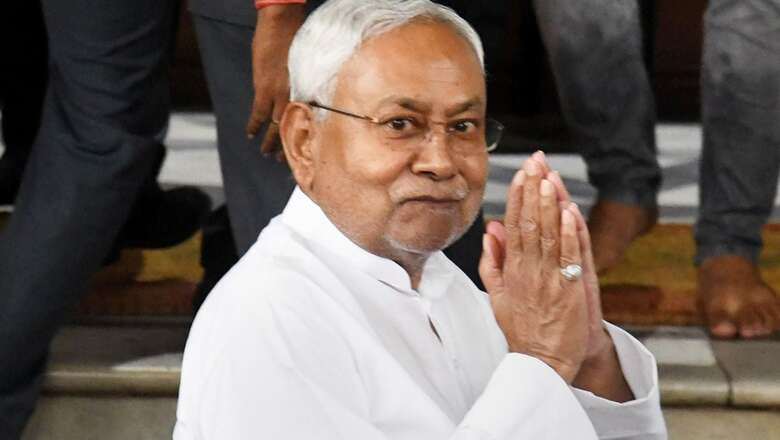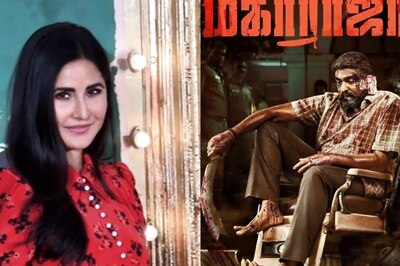
views
During the zenith of Lalu Prasad Yadav’s political influence, his supporters popularised the slogan, ‘Jab tak rahega samosa me aaloo, tab tak rahega Bihar mein Lalu’. Lalu’s tenure as the Chief Minister of Bihar came to an abrupt and unceremonious end in 1997, when he resigned after his name cropped up in various fodder scam cases.
However, in reality, Bihar chief minister Nitish Kumar has emerged as a prominent figure over the last decade, resembling a potato (aaloo) in state politics and beyond. Despite belonging to the Kurmi caste, which comprises only 2.87% of the state’s population, he has successfully maintained political relevance.
How has Kumar retained his chair for such an extended period, and why does it seem likely to continue, at least for now, despite his party never winning a majority on its own?
A closer examination of the poll numbers provides an insight into the Nitish Kumar phenomenon, as he holds the record for being in the Bihar Chief Minister’s chair for the longest time.
THE FALL OF LALU PRASAD YADAV & RISE OF NITISH KUMAR
The state, after ceding Jharkhand in 2000, has witnessed five assembly polls. The year 2005 had two assembly polls — the first in February, which resulted in the first crack in Lalu Yadav’s undisputed political fiefdom in the state, and again in October-November of that year.
The February polls resulted in a fractured mandate in a three-cornered fight, with the first front led by Yadav’s Rashtriya Janata Dal (RJD), the second by Kumar’s Janata Dal (United) (JDU) with the Bharatiya Janata Party (BJP) as a partner, and the last by Ram Vilas Paswan’s Lok Janshakti Party (LJP), which won 29 seats and emerged as a kingmaker. Paswan insisted that he would support the grouping that would put up a Muslim as CM, leading to another poll.
In the February 2005 elections, despite winning 75 seats and coming second in another 95, the RJD’s core vote bank of Backwards, Muslims and Dalits had begun to show strain.
The results of the October-November polls became a turning point, with Kumar’s JD(U) winning 88 of the 139 seats it contested, thereby becoming the largest party in the state legislative assembly. The BJP, the other NDA partner, secured 55 seats in the 243-member house, where the magic figure is 122. While the BJP had solid support from the upper castes, Kumar brought in the most backward castes disillusioned with Yadav to the NDA’s fold, making it a formidable force in state politics.
This election, much like the previous one, unfolded as a three-cornered contest. Despite contesting 175 seats, the RJD secured only 54, with a modest 23.45% vote share. In a span of just seven months, the Yadav-led party descended to become the third largest in the state. The causes behind this significant electoral setback were diverse, including allegations that Yadav’s party had transformed into a Muslim-Yadav-centric entity, sidelining the most backward castes and the Dalits. These groups, which once formed the stronghold of the party symbolized by the lantern, representing its pro-poor image, experienced a diminishing presence. Yadav’s party, once an unquestionable stronghold, witnessed a loss of support from a substantial section of the poor and the most underprivileged.
The poll results also amplified the notion of ‘gair Laluvaad,’ which became synonymous with ‘gair Yadavvaad’ in the state at the time and has remained so till now. The social foundation of Laludom, initially built on the Muslim-Yadav combination, proved ineffective.
Ram Vilas Paswan, who had played the Muslim chief minister card in a hope to corner minority community votes, was abandoned by majority of his 29 MLAs. The LJP won just 10 seats in the October polls.
THE THREE POLES
In his first term, Kumar worked aggressively on both the economic and socio-electoral fronts. This effort led to Kumar sweeping back to power with a landslide win in the 2010 assembly polls. With JD(U) winning 115 of the 141 seats it contested and the BJP adding another 91 seats, the NDA secured a whopping 206 seats, constituting 85% of the seats in the state assembly.
The radical change in Bihar’s political landscape bore fruit. The governance, which had taken a hit during the earlier Lalu-Rabri regime, was brought back on track to a large extent. Kumar reached out to non-Yadav and disadvantaged OBCs, particularly those from the extremely backward classes, the Mahadalits — the poorest social groups within the SCs, and even to the most backward and socially oppressed among the Muslims, the ‘Pasmandas,’ constituting over 85% of the community.
Another important constituency Kumar developed was that of women voters. His schemes for the welfare of girls and women, such as the Mukhyamantri Balika Cycle Yojna, earned him much applause. The improved law and order in the state under Nitish was another gift to women.
The 2010 election firmly established three political poles in the state: the first being the RJD with Muslims and Yadavs as core voters; the BJP, which has the support of upper castes, including Baniyas; and the JD(U) with Extreme Backward Castes and non-Dushadh as its core constituency.
THE NUMBER GAME
The state politics, to date, has remained tripolar. The vote is fractured in a way that it always takes any two of these three poles to come together to form the government. As the RJD and the BJP, due to ideological reasons, could not come together, it’s Kumar who jumps from one pole to another to ensure he remains politically relevant and in the CM’s chair.
In June 2013, Kumar’s JD(U) ended its 17-year-old alliance with the BJP and quit the NDA over the saffron party’s decision to declare Narendra Modi as its prime ministerial candidate for the 2014 general elections.
The next assembly polls in 2015 saw Kumar contesting in alliance with the RJD and the Congress. Despite the BJP garnering the highest vote share at 24.4% (53 seats), it suffered a shocking defeat at the hands of the Kumar-Yadav-Congress combine, which together polled around 42% of the votes. While the RJD won the highest number of seats at 80 despite having just 18.35% of the votes, the Congress added another 6.66% (27 seats). The JD(U), with its 16.83% votes and 71 MLAs, made it possible for the grouping to form a government with an absolute majority. In a nutshell, in this poll too, Kumar became both the king and the kingmaker.
In 2017, Kumar made another somersault to rejoin the NDA. The excuse this time for this ideological U-turn was corruption charges against the RJD first family.
In the next Assembly elections in 2020, the Yadav-led party secured the top spot with 75 seats and 23.11% votes, while the BJP came second with 74 seats and 19.46% votes. Despite finishing third with just 43 seats and 15.39% votes, the JD(U) became necessary for the NDA coalition to form the government in the state. One of the JD(U)’s poll banners at the time read ‘Nitish Sabke hain’ (Nitish is for all).
One significant reason for JD(U)’s below-average performance was that Chirag Paswan’s Lok Janshakti Party candidates ate into Kumar’s votes. JD(U) reportedly lost at least 25 seats due to the “vote cutter" candidates of the LJP.
LJP’s grudge against Kumar is that the latter dented Dalit votes which Ram Vilas Paswan had assiduously cultivated. Kumar’s Mahadalit reachout during his first term poached SC sub-castes like Chamar and others, while leaving Paswans with their core Dushadh vote bank.
In November 2020, Kumar took the oath of Chief Minister for the seventh time with BJP’s support, and with Tarkishore Prasad and Renu Devi of the saffron party as his deputies.
Kumar went back to the RJD in August 2022 and is now set to align with the BJP again.
A NECESSITY AND COMPULSION
Both Kumar and the BJP need each other. The alliance will help Kumar overcome long-standing anti-incumbency, leveraging Modi’s popularity. Besides, reports suggest that Kumar was under pressure from Lalu’s family to hand over the CM post to his deputy, Tejashwi Yadav. There is not much scope in the INDIA alliance for him either, as the grouping under the Congress is not ready to give him a key position.
For the BJP, winning back Kumar, the prime architect of the opposition unity alliance, will be a significant victory and virtually mark the end of the opposition grouping. Additionally, post the Karnataka debacle, the saffron party is wary of fighting a lone battle against the mighty RJD. Not to discount the fact that the conduct of a Caste Survey in the state has bolstered Kumar’s image among the backward castes nationally. Kumar’s clean image and anti-dynasty stance come as other reasons to court him, as well as the fact that his Kurmi caste has a presence across major North Indian states.
As of today, Nitish Kumar is both a necessity and a compulsion in Bihar politics. A compulsion because the side he takes tends to become the winning side in a state where the mandate remains fractured. A necessity because his past developmental works still resonate in a state where poor governance had acquired the blot of ‘Jungle Raj.’ Besides, despite his party losing much sheen, he remains the tallest leader in the state.
Kumar won an Assembly poll only once, some 39 years ago in 1985. Throughout his term as Chief Minister, he has served as a Member of the Legislative Council (MLC).




















Comments
0 comment